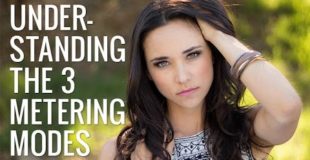Light is quintessential when it comes to photography, and understanding how your camera meters light is just as important. Spot Metering, Matrix Metering, 18% Grey, do any of these words mean anything to you? If not, then this video will teach you everything you need to know.
Product Link: http://www.slrlounge.com/store-product/photography-101/
Article Link: http://www.slrlounge.com/school/understanding-3-primary-metering-modes-photography-101
All Images Copyright Lin and Jirsa Photography: http://www.linandjirsa.com
http://www.linandjirsablog.com
Original source

26 responses to “Understanding The 3 Primary Metering Modes | Photography 101”
Thanks a lot!
What lapel mic are you using? Sounds awesome.
You should have used weighted in this video because the background is totally overexposed
I always use spot metering. Meter on the skin and then recompose the shot. If the subject is moving then I might see myself using center weighted. Cameras see 50% gray not 18. Good Video though.
sorry to say this vid is useless! exposure comp & locking exposure means you could have spot metered from anything in that scene to get the exposure you want. Meter from her hair with – 1 stop or meter from her dress at +1 stop or from her left cheek at + 1/3 of a stop would have worked nicely. No wonder why so many people struggle with exposure if this is the way you go about explaining metering….
What is the best meter mode for acton shots?
thanks for the fantastic explanation, Pi (Pie), don't know the exact spelling of your name ! . . . would like to know which country are you originally from ? . . . India ?
So I always shoot in manual mode, and mostly just shoot senior portraits and couple sessions. Would you recommend that I spot meter instead of doing the average metering?
in manual mode, I use spot and focus on the same part to meter. I rarely use automatic modes, but when I do, it certainly pays off to use a broader metering. Otherwise the pictures change way too much, and getting a similar set of pictures becomes much harder.
From an amateur, best video I've watched on metering yet. Thank you!
Nikon's original N90 (1992) did not come with spot metering. This is why two years latter they produced the N90s. I mention this for film shooters because the N90 is an incredible camera that can now be purchased for about $50, but you have to get the N90s if you need (and everybody does) the spot metering. It's a great deal for a camera that last sold new for $1000, and was introduced at $1500. For digital I prefer the D3300 with the 35mm 1.8 Dx which actually out performs both the D3400 and D5300 with this awesome lens. Most of what I shoot is done with spot metering, but for walking around prepared to shoot anything I switch to matrix metering. I probably use center weighted metering less than 10% of the time. Metering really hasn't changed much over time, and the biggest difference I find with the transition to digital is in the use of ISO. With film once the selection of film speed is made you are committed, and shutter speed and aperture are your primary concerns with exposure. I know adding in this 3rd variable can improve a photograph, but I'm not yet experienced enough with digital to use it to my advantage.
where did you meter on the model when you were using the center weighted metering mode?
All this is so easy with mirrorless cameras.
suparrr video
Why are you using such a high shutter speed when the object is stationary?
wow she's hot 😉
Dank
I've never even paid any attention to the metering on any of my cameras. So the only way this effects the quality of your image or video, is if you're using that to gauge the correct exposure your camera is telling you right? I know you might be thinking I'm an idiot (and I am lol) but I just never paid much thought to this.
That was informative, thank you. Great job staying on point and moving through it quickly.
nice
so the spot meter adjust the shutter speed for u or u manual adjust the shutter speed. Are you using the manual mode right?
I've watched quite a few metering videos, yours explained well with demonstration, exactly what I was looking for, Thank you!!
Thanks for all the tips. Ive mostly always used spot metering but it makes sense to use Centre weighted especially in aperture priority.
Does metering actually change the exposure, or is it just telling me whether my image is under/over exposed so that I know to change either my aperture or shutter speed? I know this is a dumb question, but I'm having a hard time finding an answer to it.
SOOC what does it mean?
Your voice is frigging amazing.